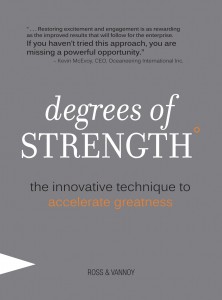There isn’t a job anywhere that’s worth losing a limb or a life for. But before anyone shouts, “Safety is priority #1”…when isn’t safety a priority?
Three situations when playing it safe hurts people, partnerships and performance:
1) …when a person works hard to save their reputation – rather than being honest about the data in front of them.
It’s unsafe to your “ego” to look at something with a new perspective and tell the truth about what you see. Be unsafe anyway, and show your true character.
2) …when you keep your mouth shut, because offering a new perspective or idea means we could be (gasp!) wrong. It’s tempting to play it safe and be irresponsible by not providing our best thinking. (As Rachel, the featured leader in Degrees of Strength, says, “The greatest issue in leadership is so few people take responsibility.”)
Instead of letting your team play it safe, ask questions that assist them in offering their true perspective – and no matter what they say, thank them.
3) When someone insists on moaning and lamenting how no one takes accountability, that person is under the illusion of safety: “If I complain about others I shed responsibility, so I can’t be blamed.”
Why point at who put the hole in the boat…when it’s plugging the hole that needs to be accomplished? Encourage your team to take the less “safe” route by stepping forward and modeling accountability. This may seem unsafe (because you may be alone). Do it anyway – people will follow.
This week, ask your team: “When it comes to the mindset and behaviors needed for us to be successful, which approaches would be playing it safe – or unsafe?” Share answers in the comments box below.
Want to focus your team to be even more capable, agile, and perform better than they’ve ever done? Degrees of Strength shows how. Order Now to accelerate your greatness in 2012.
Sign up for free to be part of our A-team and you’ll get free resources delivered straight to your inbox. Coming Soon: Team Acceleration Guide. Click Here for access.
“This book is outstanding! The entire technique is the most amazing leadership tool I have ever found. My corporation is currently in the middle of the Pathways to Leadership® program from Verus Global and in just 10 weeks I have seen amazing transformation in our organization and my team. Most importantly I have seen the most change in myself and my leadership technique…”
– kiwisarah98 (via Amazon.com)
“Degrees of Strength is an excellent book that will help you recognize the strengths of your friends/coworkers/employees/children instead of trying to make them something they are not. Not everyone is the same but everyone wants to be great, help them be great by setting them up for success instead of failure. Recognize the strengths of those around you and you will be amazed at what happens to you family or organization. The results will be amazing! Degrees of Strength has many great real world examples of the results and thought process behind this greatness.”
– Nick Corder (via Amazon.com)



I think the above article is a good one. It gives good advice and reminds us to check ourselves to make sure we are being honest.
The only criticism I would offer speaks to the way you present your message in this particular article. You have a good message, but you force a negative thought into peoples mind straight away (namely that safety is something to use as a target in confusing metaphores). Here are a few points, IMHO, to consider:
1) Safety is ALWAYS a priority. You should never minimize this by asking when is it not a priority. If you work in the field you will understand, if not, just take the word of one who does. Safety is SACRED in industry, disregard that at your own peril.
2) You are unfairly calling you reader irresponsible. If they have kept their “mouth shut” in the past, there were probably good reasons. It is pretty amateur to present a point like that and then offer NO evidence. You ask your reader to turn away and ignore your message when you insult them so.
3)WoW! Are you confused? In point number 2, you quote your “featured leader” as saying: “The greatest issue in leadership is so few people take responsibility.” but in point 3 above, you insult us again: “When someone insists on moaning and lamenting [read bitching 😉 ] how no one takes accountability, that person is under the illusion of safety.” Which is it? Is it the greatest issue or is it “…moaning and lamenting…”?
As to your final question: “When it comes to the mindset and behaviors needed for us to be successful, which approaches would be playing it safe – or unsafe?” Personally, I will play it safe EVERY TIME. I think that you will find that those in industry will agree with me on this. I understand that this is a metaphore (as stated above), I just think it is a very irresponsible way to present your point. PLEASE leave safety alone in the future.
Qwibqwib
Qwibqwib – I’m glad you’ve jumped in on the conversation. We owe you and others who hold your perspective a sincere apology. We have a lot of great and dear friends who lead and work in the arena of developing safety – to think that we could have offended them or others causes me pause (and a wiser use of words in the future). We agree and are aligned: Safety should never be compromised.
Best wishes to you as you lead forward. Your feedback is valued. Your passion is prized.
Comment*
As a safety professional, I was pleased to see the mention of the ‘S word’ in this article. In my experience, ‘Safety’ can be used by some as a smokescreen to cover a lack of well-thought out or planned action, or to ‘argue’ why we ‘can’t do something’. In this way, we might consider that people are ‘playing it safe’ with safety.
So, I’m not overly-concerned with the use of the word ‘safety’ in this article, and in fact believe it’s been constructive for us to consider how we use it more generally.
Given the point made by the article, and endorsed by Qwibqwib that safety should always be a priority, how about a Leadership post from Messrs Ross & Vannoy on the value of safety, or suggestions on how to integrate safety into the minds and vocabularies of organizational leaders?
Andrew – your perspective increases our scope of understanding. And I greatly appreciate your focus on purpose. Especially how – whether we agree or disagree (and we agree on safety) – greater value comes in having an important conversation. And consider your recommendation that a future post feature more “how to” well received. Look for it soon! Thanks – Craig